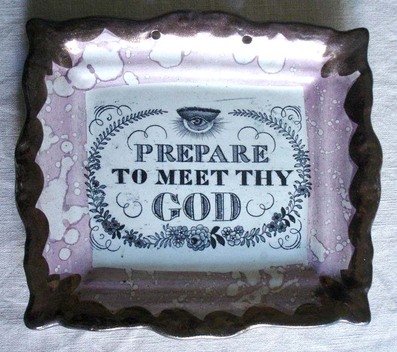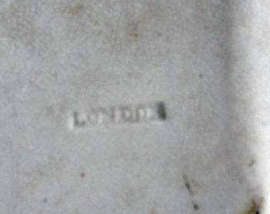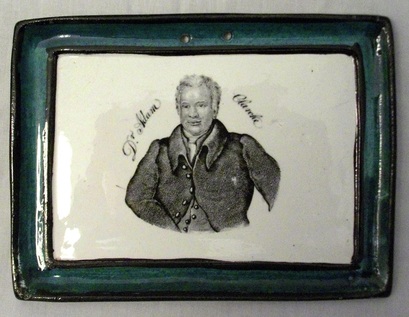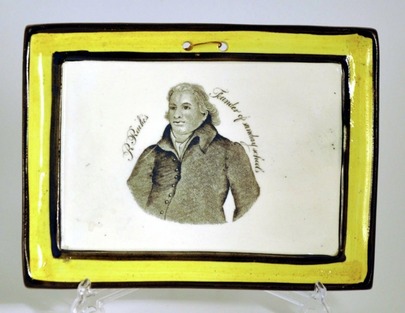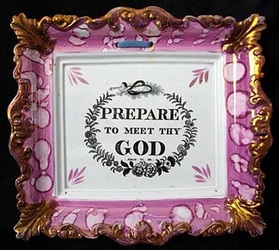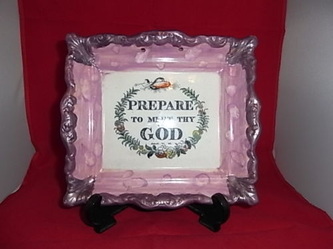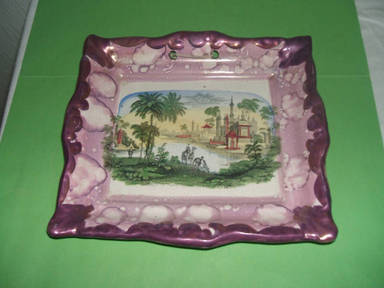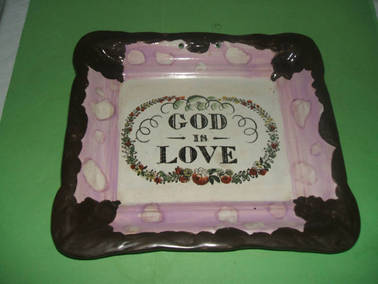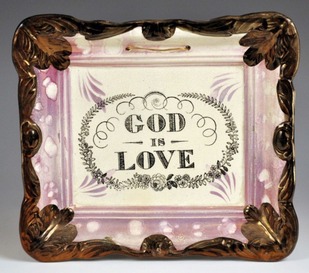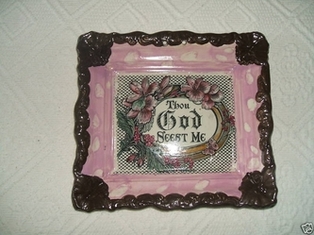|
10/29/2010 0 Comments 'LONDON' impressed markThank you to the collector who sent me the photos below. The plaque, at first glance, is nothing out of the ordinary. The transfer is one found commonly on larger plaques attributed to John Carr's Low Lights Pottery, North Shields. What makes this plaque unusual is the impressed mark 'LONDON' on the reverse. So does this mean there was a pottery on the banks of the Thames churning out lustre plaques? I'm afraid not. It seemed more likely that a North East pottery had used the LONDON imprint on a plaque destined for a London distributor or retailer. Dick Henrywood directed me to the Northern Ceramic Society newsletters 83 & 110, in which John Cockerill and Clarice Blakey discuss the use of the 'LONDON' impressed mark. Their articles confirm that it was used by several potteries in the North East. Blakey states:
The five reported users of the LONDON mark are: Middlesbrough Pottery, 1834–52 Isaac and Thomas Bell, Albion Pottery, 1860–63 Carr & Sons, Low Lights Pottery N. Shields, 1844–c 1900 Malkin, Walker and Hulse, British Anchor Pottery, Longton, 1858–64 Fell & Co, St Peters Pottery, Newcastle on Tyne, 1817–1890 So we are back to where we started, with a plaque, most probably John Carr & Co, stamped LONDON for distribution there. As always, if anyone else has an item of lustreware marked LONDON, please share it. P.S. I think this explains the mystery mark on a Carr-type plaque, mentioned in my 30 May 2010 blog post. Look at the mark above. Isn't it just possible that a cataloguer might have mistaken an indistinct impress, particularly if viewed upside down, for 'MOORE'?
0 Comments
10/26/2010 0 Comments Preacher plaquesI was sad to miss out on the plaque below, which recently sold on eBay for a tidy sum. Note that Clarke is misspelt as 'Clarcke'. It is from the same series as Robert Raikes (on the Portraits page). The text to the right of the transfer reads 'Founder of Sunday Schools'. I'm guessing there must be other preachers in this series. Not least of all a Wesley.
10/13/2010 0 Comments More on over-painted plaquesBy my estimation, there must now be 100s of items of lustreware (not to mention cow creamers) that have been over-painted by the eBay seller mentioned in my last post, who I'll refer to as Edmund for simplicity's sake. The majority are in the collections of those he's conned through eBay. However, there's evidence he's off-loaded some through auction houses and private sales. I contacted an eBay seller last year who tried to sell the 'Thou god...' plaque in my previous posting, unaware of its flaws. He returned it to the auction house where he bought it. They said they knew of 'Mr Edmund's activities of old', but this one plaque had 'slipped through the net'. A reputable dealer recently reported that other over-painted items appeared at Newark this year. Once Edmund had been exposed, he removed his additions (with paint stripper) from the more valuable items in his stock, and sold them legitimately as original. However, for the next few decades, over-painted items will resurface on eBay, at auction houses or fairs, and perhaps the secondary seller won't be aware of Edmund's embellishments. I've much sympathy for those who've bought Edmund's items in good faith, only to realise they are aren't what they seem. That's why I've held off, for 24 hours, writing about another plaque on eBay, which bears all the hallmarks of Edmund's handiwork. I contacted the seller and set out my case, asking whether he acquired it from a Mr Edmund B Edmunds of Torfaen, Wales. His response was, perhaps understandably, less than sympathetic. The seller writes: I recently inherited this item from a friend who had collected this stuff over many years, I know very little about it and am unable to tell if it has been overpainted. Please dont bid if you are unsure. Wary of conducting a witch hunt, I showed the listing to Dick Henrywood, who also collects plaques, before writing this post. He agrees that the plaque is more than likely overpainted. I include three pictures below to help you make up your own mind. The plaque on the left is guaranteed original. The plaque in the centre is the one currently listed on eBay. The plaque on the right is one of Edmund's over-painted items. Click on the images to enlarge, and use the arrows to move between images. As the seller says, if you're unsure whether the item is over-painted, please don't bid.
If, like me, you've purchased an item with fake over-painting, you have real choices. Firstly, deny any knowledge of the over-painting, and try to rake back a few quid by selling it as original. Or secondly, scream from the rooftops that you've been conned. It all depends on whether you'd rather be part of the problem, or the cure. As always, I'm happy to provide advice to anyone concerned about an item they've purchased which might be over-painted. The complaints I've had so far are now in double figures. 10/12/2010 0 Comments Acceptable restoration or fake?Myrna Schkolne has debated how much repair or restoration should be acceptable to collectors (see her blog piece 'A perfect 9'). I suppose much depends on why you collect. For plaque collectors, it's quite feasible to build up a collection of perfect examples, for relatively little money. For those like me, however, who want to assemble as much knowledge, as quickly as possible, a hairline crack or even a missing corner, won't put them off a rare plaque. Who knows? It might be 10 years before another comes along. But one thing I think we all agree on, is that an item covered in heavy modern over-painting has next to no appeal. Over the last few years I've been following the progress of an eBay seller, 1079edmund, who purchased rubbed or plain items and embellished them with fake over-painting. See my March 2010 blog postings and the Fake over-painted items page for the full story. Despite a large spread in the Antiques Trade Gazette and many complaints to eBay, 1079edmund has continued to trade. A few months ago he changed his eBay identity to toby-20. Take a look -- the same feedback history, the same private listing auctions, the same photographic backgrounds, the same appalling spelling, and the same location, Wales. It's the same eBay account with a different name. Until now, the items he's listed, under his new identity, appeared untampered with. So who was I to knock a man who'd turned over a new leaf? But over the last few weeks, toby-20 has listed two plaques I've felt unsure about. The first, a typical 'Eastern scene' (see below), looked to have perfectly original enamelling to the central transfer. Unusually, the outer borders are pink rather than copper lustre. But that's possible for late items stamped 'Dixon Co'. However, the irregular-looking corners might suggest over-painted damage, and I don't recall ever seeing an outer border quite so purple. You'll have to make up your own mind about this one, because I'm not sure. The second plaque, currently listed on eBay, looks all wrong. What should be dark and rich copper lustre in the corners is flat and brown. The pink lustre on these 'Carr' plaques is usually very deep, almost purple. Compare toby-20's plaque to the plaque with real lustre (second picture). In fact, the only place I've seen this combination of colours is on 1079edmund's faked plaques (see below). So if the lustre was rubbed or faded, and the seller decided to over-paint 60% of its front surface, has this plaque been acceptably restored? Note that the seller doesn't list any restoration in his latest listing. My frustration here isn't with a petty criminal, who can't resist the compulsion to smear antique objects with household paint. It's eBay who are at fault. They choose to ignore complaints from buyers, after the event, because the seller has 100% positive feedback rating. Despite a marketing pledge to tackle antiques fraud, every 'improvement' to eBay's site over the last few years appears to be designed to protect their revenues. Come on eBay, isn't it about time you put your buyers first?
If you are sure that an eBay item looks wrong, click on 'Report item'. Then select 'Fraudulent listings' and 'You suspect a listing is fraudulent (you didn't bid)'. In the above case I gave the description as 'Fake over-painting, item listed as restoration free'. Though my faith in eBay is rock bottom, if enough people complain they'll surely have to do something. |
AuthorStephen Smith lives in London, and is always happy to hear from other collectors. If you have an interesting collection of plaques, and are based in the UK, he will photograph them for you. Free advice given regarding selling and dispersal of a collection, or to those wishing to start one. Just get in touch... Archives
February 2022
AcknowledgementsThis website is indebted to collectors, dealers and enthusiasts who have shared their knowledge or photos. In particular: Ian Holmes, Stephen Duckworth, Dick Henrywood, Norman Lowe, Keith Lovell, Donald H Ryan, Harold Crowder, Jack and Joyce Cockerill, Myrna Schkolne, Elinor Penna, Ian Sharp, Shauna Gregg at the Sunderland Museum, Keith Bell, Martyn Edgell, and Liz Denton.
|
